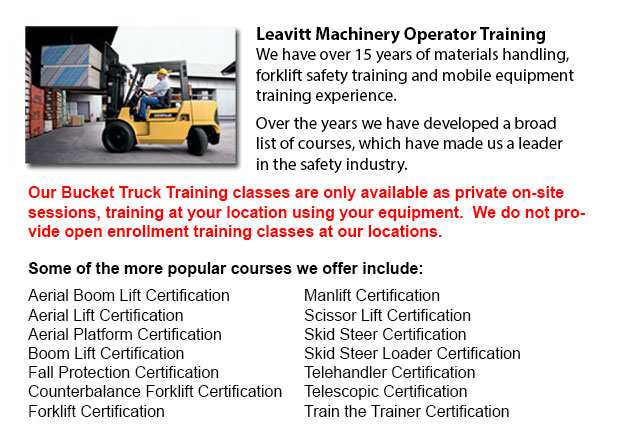
Warehouse Forklift Training Programs Prince Albert - Warehouses could be industrial, commercial or retail facilities. Their function can vary from retailing bulk products to product distribution. Regardless of the kind of warehouse, workers inside warehouse settings must be trained correctly in safety measures related to material storage and handling, loading docks, conveyor systems, and forklifts and pallet jacks. Good housekeeping is vital to an orderly and safe warehouse environment.
Truck and loading dock systems are frequently located at a height from the ground. Products exit and enter warehouses through these systems where staff load and unload supplies from elevated docks and ramps. Particular attention should be paid to safety habits in this stage. To be able to avoid falls, install yellow striping along the edge of docks and ramps. Pay attention to the area around delivery trucks which are parked at the loading dock, especially the area between truck and dock. Be sure that while unloading, truck wheels are chocked.
To be able to distribute products inside the facility, some warehouses make use of a conveyor system. These systems are designed with moving belts and wheels which may pose a pinch point hazard. Keep body parts and hair far away from conveyors to prevent injury. Elevated conveyors pose a danger to staff below if safety nets are absent. Employees need to know how to stop conveyors in case of emergency. Be aware of the location of off switches and emergency stop buttons. When servicing conveyors, tag out/lock out procedures are mandatory.
To make it easier to move supplies, forklifts are pallet jacks are most usually utilized. The operator of the lift truck would require training and certification. Pallet jack operators do not require certification, but must be trained on the equipment. Training programs instruct operators in the correct methods for lifting materials and moving them to their assigned location. Neither pallet jacks nor forklifts should ever be used to transport or lift employees.
Storage shelving and rack systems help to create an efficient and orderly work area if they are sturdy, braced, and allow enough room for individuals and machines to pass. Careful and slow placement of good is needed to avoid accidents caused by products falling off the facing aisle. Aisles should be kept clear by storing products flat and inside the shelving units. Pallets are utilized for stacking products. They must be in good condition, and palleted products must be shrink-wrapped or baled, whenever possible.
PPE or personal protective equipment should be worn when required to help protect the workers' limbs, heads, feet and hands. Hard hats or bump caps, gloves and steel-toed shoes are common PPE.
Slippery floors that are pocked with dents and pits can present significant dangers, making good housekeeping really important. Warehouse floors and docks must be clear of dirt, debris and oil. The area should be kept clear of boxes, baling materials and garbage.
-
Zoom Boom Training Prince Albert
Zoom Boom Training Prince Albert - Zoom Boom Training focuses on correctly training potential operators on variable reach forklifts. The training objectives include gaining the understanding of the machine's physics and to be able to define the job o... More -
Bucket Truck Training Prince Albert
Bucket Truck Training Prince Albert - The Vehicle-Mounted Aerial Work Platform or also called bucket truck training program is intended to reduce the chance of incident and personal injury when working with or in close proximity to bucket trucks by e... More -
Aerial Lift Training Prince Albert
Aerial Lift Training Prince Albert - An aerial work platform is a mechanized access platform. This device provides access to otherwise not accessible places for people or equipment. Likewise called an aerial device or elevating work platform, the mac... More -
Overhead Crane Ticket Prince Albert
Overhead Crane Ticket Prince Albert - The overhead crane is a common heavy machinery utilized in industrial settings. This particular machine is known as a bridge crane and comprises parallel runways spanned by a traveling bridge. The hoist is the co... More -
Scissor Lift Ticket Prince Albert
Scissor Lift Ticket Prince Albert - Scissor lifts have greatly benefited construction operations because the task that used to need a lot of effort and lots of people, can now be accomplished using the scissor lift and just one individual, the operat... More -
Manlift Training Prince Albert
Manlift Training Prince Albert - Different manlift training programs include the review and content of manlift devices. An essential part of the program is the practicum where students demonstrate their knowledge and practical ability to operate the... More -
Skid Steer Loader Training in Prince Albert
The engine powered skid-steer loader consists of a rigid and small frame, equipped along with lift arms which could attach to various industrial attachments and tools to be able to perform various labor saving tasks. Normally, skid-steer loaders are... More -
Crane Training School Prince Albert
Crane Training School Prince Albert - We provide industry relevant programs in our crane training school. The course will provide our trainees with learning outcomes matching the existing industry demands. Our small class sizes combine theory and han... More

Forklift Training Prince Albert
TOLL FREE: 1-888-254-6157
Prince Albert, Saskatchewan
forklifttrainingprincealbert.com
Email Us
About Us


